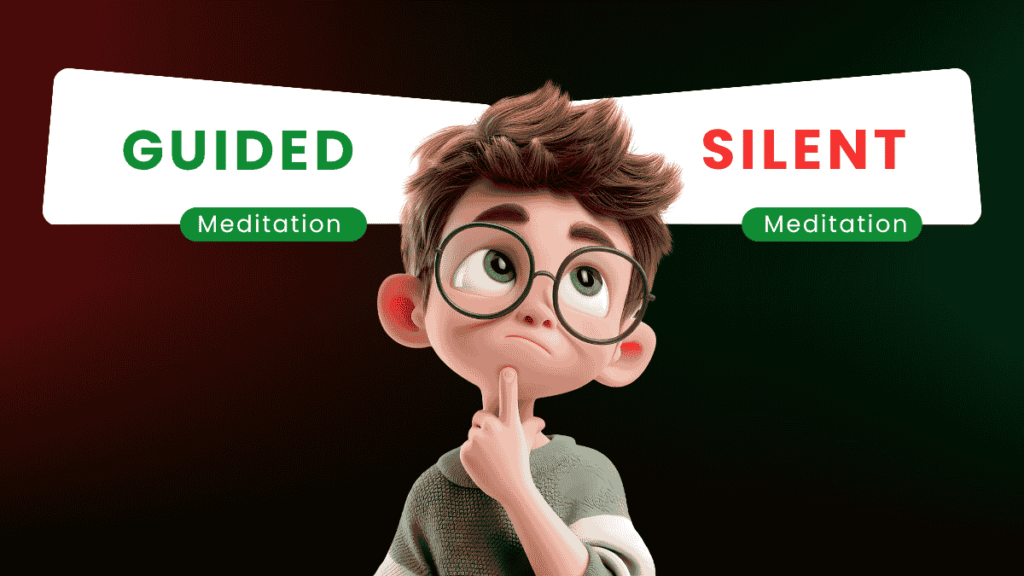The question of guided vs silent meditation often arises when someone begins their mindfulness journey. Both practices lead to calm, focus, and emotional balance, yet they do so in different ways. Choosing between them depends not on which is “better,” but on which resonates with where you are right now.
Guided meditation uses a voice or audio track to gently lead your awareness through breathing, visualization, or reflection. Silent meditation, by contrast, removes external guidance and invites you to explore stillness directly. Each style has unique strengths, and many meditators combine both over time.
This article explores how each form works, their benefits, and how to know which one best fits your needs. You’ll also find gentle guidance on transitioning between the two, so your practice evolves with your growth.
The Essence of Guided Meditation
Guided meditation is a structured practice led by a teacher or recording. It offers verbal cues that direct focus, explain techniques, and help manage distraction. For beginners, this form often feels like a supportive hand—steadying and encouraging when the mind wanders.
Each session may center on a specific theme: relaxation, gratitude, emotional healing, or focus. The guide’s voice and pacing anchor your attention, making meditation less intimidating for those new to silence. Music or nature sounds may accompany the voice, creating a calm atmosphere that helps shift the nervous system into relaxation.
I’m Dr. Ghazala Tahir, founder of Mind Healing Ghazala and the guiding voice behind Your Guided Meditation. With more than ten years of experience in hypnotherapy, NLP, energy healing, and life coaching, I’ve helped hundreds of people build sustainable self-care habits that reduce stress and support emotional wellbeing. Meditation, whether guided or silent, is one of the most powerful ways to begin that process.
Guided meditation works beautifully when you need direction or emotional support. It can reframe thoughts, calm anxiety, and introduce techniques you might not discover alone. However, its strength in structure can also limit self-exploration if you rely solely on guidance. The balance lies in using guidance as training wheels—helpful at first, but not forever.
The Essence of Silent Meditation
Silent meditation removes external instruction. You become your own guide, using inner awareness as the teacher. This style deepens self-reliance, focus, and mindfulness.
At first, silence can feel uncomfortable. The absence of cues reveals how noisy the mind truly is. But within that quiet, you begin to see your thoughts clearly. Instead of reacting to them, you learn to witness them with compassion.
Practitioners of silent meditation often focus on breathing, bodily sensations, or awareness itself. This approach strengthens discipline and develops a stable mind that can stay centered even in life’s turbulence. Over time, silence becomes nurturing rather than daunting.
Silent meditation invites maturity of practice. When external noise fades, the subtle layers of awareness—the emotions, sensations, and stillness beneath thought—begin to emerge. This is where profound insight grows.
For experienced meditators, silence can feel like home. It allows direct connection with inner wisdom without external input. Still, beginners can also benefit by starting with short silent intervals after guided sessions, gently increasing duration over time.
Comparing Guided vs Silent Meditation: Key Differences
Understanding the distinctions between guided vs silent meditation helps you choose the approach that aligns with your personality, goals, and current stage of practice.
| Aspect | Guided Meditation | Silent Meditation |
|---|---|---|
| Support | External voice or music provides direction and comfort. | You guide yourself through breath or awareness. |
| Best For | Beginners, those experiencing anxiety or mental restlessness. | Intermediate to advanced practitioners comfortable with stillness. |
| Focus Type | Specific themes like relaxation, healing, gratitude. | Open awareness, breath focus, or self-inquiry. |
| Ease of Entry | Easier to start; less intimidating. | More challenging at first; requires patience. |
| Growth Potential | Builds understanding and emotional insight. | Deepens discipline, awareness, and self-trust. |
| Tools Needed | Audio recordings or live guidance. | Quiet space and your own awareness. |
The two forms are complementary rather than competing. Many people begin with guided meditation for structure, then integrate silent practice to deepen self-awareness. The goal isn’t to choose one forever, but to let each serve its purpose.
When to Choose Guided Meditation
Choose guided meditation when you need reassurance, structure, or focus. It’s especially helpful in these situations:
- Beginning your journey – Guidance introduces meditation safely and gently.
- Managing stress or anxiety – A calm voice and soothing pace can regulate breath and nervous system.
- Healing emotional wounds – Themed meditations on compassion or self-worth provide therapeutic support.
- Building consistency – Structured audio helps sustain routine through gentle accountability.
Guided practice transforms meditation from an abstract idea into a tangible habit. It offers companionship in moments of overwhelm, allowing you to experience calm without having to figure out every detail.
